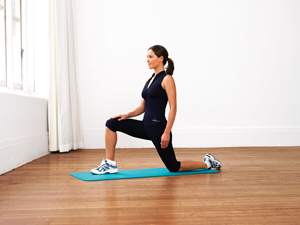Low back pain? Prevent it with these exercises:
The following stretching and strengthening exercises are intended to be used to help prevent low back injury. You should regularly be performing exercises that stretch and strengthen the structures that support your spine to alleviate pain and prevent recurring back problems. Please consult with your doctor before starting an exercise routine to develop a comprehensive treatment plan, and work with an appropriate therapist on the proper form for these exercises. Generally speaking, these exercises can be done every other day. It is usually advisable to give your muscles a day's rest in between, so be sure to allow them time to recuperate – it will only serve to help you heal and prevent further injury.
Caution: some exercises can aggravate back pain. If you have low back pain, avoid:
- Straight leg sit-ups.
- Bent leg sit-ups or partial sit-ups when you are experiencing back pain.
- Lifting both legs while lying on your back.
- Lifting heavy weights above your waist (standing military press or biceps curls).
- (Straining) toe touches while standing.
Stretching your hamstrings:
Your hamstrings run down the back of your thigh. Stretching your hamstrings increases the range of motion for your pelvis, which can decrease the stress you may feel across your lower back. Try each of these exercises, without straining too hard to perform them.
Standing Hamstring Stretch
While standing, simply bend forward at your waist with your arms hanging down until you feel a stretch in the back of your legs. Touch your toes if possible, but do not strain to do so. If you find it difficult to keep your legs straight, bend your knees slightly.
Hold this position for 30 seconds, and then slowly come back up to a standing position. Repeat and hold for longer when it begins to feel easy for you.
Yoga Strap Hamstring Stretch
Lie on the floor, and pull one leg up, straightening it while holding onto a yoga strap (or a towel if a strap is not available) that is wrapped behind your foot. Stretch one leg at a time, keeping your passive leg on the floor, straight and not bent. Perform 10, 3-second stretches for each leg.
Stretching your hips:
Like your hamstrings, flexible hip muscles can help alleviate some of the pain in your lower back by increasing the range of motion in your pelvis. In terms of stretching your hips to prevent low back pain, think of your hips as three main parts: your hip flexors (the front side of your hips), your piriformis muscle (which runs from your sacrum to the top of your thigh bone), and your lower back itself, whose muscles connect to your hips in a number of ways.
Piriformis Muscle Stretch
The piriformis muscle runs through your buttocks and can contribute greatly to low back pain or even leg pain. To stretch this muscle, lie on your back and cross one leg over the other. Then gently pull your other knee towards your chest until you feel a stretch, however slight, in your buttock area. Perform 10, 3-second stretches for each leg.
Back Flexion Exercise
While lying on your back, gently pull both of your knees to your chest while keeping your head down on the floor. You may need to interlock your fingers to hold this position, but try to do so for at least 30 seconds, feeling a gentle stretch in your lower back.
Pelvic Tilt Hip Flexor Stretch
Kneel on something soft, such as a folded towel. Place your right foot flat on the floor in front of you, so that your thigh is parallel to the floor and your knee is bent 90 degrees. Put your right hand on your right thigh, and place your left hand on your left hip. Activate your abdominal muscles and gently tilt your pelvis upwards so that you feel a stretch in your left hip and thigh. Perform 10, 3-second stretches for each leg.
Strengthening your core:
While it is imperative to stretch the right muscles to prevent low back pain, it is also vitally important to strengthen other muscles. With the right tone in certain muscles, you can help to relieve low back discomfort, and also strengthen the right muscles to prevent further injury.
Caution: many people feel that to prevent low back pain, they should do exercises that focus solely on the lower back. While this may help somewhat, it may also cause further injury. Therefore, it is recommended that you do strengthening exercises that work on strengthening your lower back in a cross-planar (i.e. across more than one plane of motion) fashion, as well as certain abdominal exercises. The following are good examples of this recommended type of training:
Superman
This exercise strengthens the muscles that extend your spine, and can ease low back pain. Lie face down on the floor (or over an exercise ball, facing downward). Lift your left arm slowly, while also lifting your right leg, just a few inches. Hold this position for 5 to 10 seconds, then lower back down. Now raise your right arm and left leg in the same manner. Repeat for 10 repetitions on each side.
Alternate Leg Lifts
Lying on your back with your legs straight, lift your left leg up, no farther than 90 degress. Then lower it slowly back to the ground, and repeat the same action with your right leg. Perform 10 to 20 per side, stopping if you feel any strain in your lower back.
Cable Lift or Exercise-Band Squat with Lift and Push
This exercise can be done with a cable machine at a gym, or using an exercise-band elsewhere. Using a cable machine, start with a low weight, and if using an exercise-band, make sure that you choose the appropriate tension. To determine the right weight or tension for you, consider choosing one that will cause you to begin tiring at about 15 to 20 repetitions.
To begin the exercise with a cable machine, lower the cable pulley to the lowest setting and stand sideways (90 degrees) to the machine, with the machine on your left side. Then squat down and turn to pick up the cable pulley handle with both hands.
Using an exercise band, stand on one end of the band with your left foot, and gather enough of the band in your left hand (and the remainder in your right) so that the band is fairly stretched when standing. Then squat down to begin the exercise.
Holding the cable pulley (or the exercise band) in a squat position, pull your hands towards your chest. Then begin to stand, and as you do, turn your shoulders to the right, keeping your hands in front of your chest. Then, continue the motion so that you push up and away to the right. Then slowly reverse the motion until you are back to squatting in the start position. Repeat for 15 to 20 repetitions, and then perform the same exercise on your other side.
By Richard Lobbenberg, BSc BHSc DAc
These links may also be helpful:
Chiropractic for Low Back Pain















